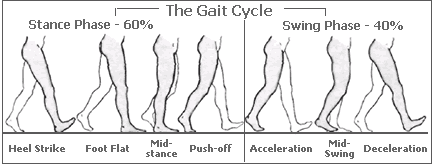Foot Function and the Gait Cycle
Foot function describes the way the foot moves every time we take a step.
To propel us forward efficiently, each foot must change between being a strong rigid structure and a softer more flexible one.
The combination of the stable and sturdy 3-arched bone structure and the more mobile and elastic soft tissues means that foot function alternates between the following states:
- a mobile adapter – the soft tissues expand and the foot pronates, which allows the arches to lower. This flexibility prevents damage and jarring to the weight-bearing joints;
- a rigid lever – the soft tissues contract and the foot supinates, which causes the arches heighten. This rigidity provides strength and power that propels us forward.
The sequence and timing of the foot motion as it switches between a mobile adapter and a rigid lever is termed the Gait Cycle (details below)
Foot function is heavily influenced by underlying foot shape variations:
- A varus deformity will cause over / hyperpronation throughout the gait cycle
- A valgus deformity will cause over / hypersupination throughout the gait cycle
The most effective way to correct foot function is through prescription orthoses (shoe inserts made of rigid material that angle the feet into a more stable position).
Knowing that foot function is impacted by structural varus or valgus deformities is one thing; working out the most effective prescription to correct it is quite another.
Most prescriptions involve some degree of ‘posting’, where wedged are placed under the rear and foot foot to help build up some of the gap between the ground and the natural position of the foot.
Many practitioners use tools like these to help them get the prescription as accurate as possible:
- video gait analysis to study the movement of the foot, leg and ankle
- pressure sensitive pad systems such as TOG Gaitscan (in video below)
The Gait Cycle
The Gait Cycle begins when the heel of the left foot first comes into contact with the ground (heel strike), and ends with the next heel strike of the same foot. The diagram below shows the phases of the Gait Cycle:
Here, the foot is a rigid lever. With the soft tissues contracted, the bones of the feet and lower limbs are pulled closely together. This enables the force generated from striking the ground to be transmitted throughout the body with the minimum of disruption to the weight-bearing joints throughout the body.
Foot Flat and Mid-stance = Mobile Adapter
As the rest of the foot comes into contact with the ground, the soft tissues expand and the arches lower. This soft-tissue action opens up (loosens) the joints within the foot and lower extremities (ankles and knees). This loosening and lowering enables the lower limbs to internally rotate; an action which enables the force generated by the weight of the body to be absorbed as it is transferred vertically over one foot.
Whilst the foot functions as a mobile adapter, it is also able to adapt to uneven ground conditions.
Push-Off = Rigid Lever
Finally, after the heel of the foot lifts off the ground, the foot begins its’ return to a rigid state.
The soft tissues contract and the arches re-form, externally rotating the joints in the foot and lower limbs so that they become close together. This action is akin to releasing a loaded spring, where the internal rotation and shock absorption that occured during the Mobile Adapter stage created the energy. The power that this “spring release” provides gives strength and stability to the forefoot, allowing it to push off from the ground and propel the body forward.
